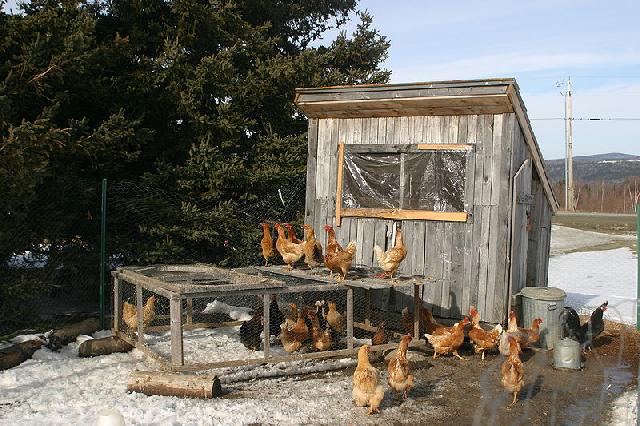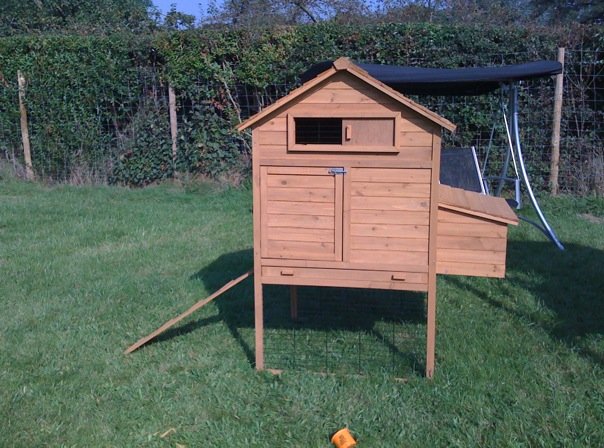Poultry can be made to do well almost anywhere, just as cattle are made profitable on many farms not especially adapted for dairying. Management and system of housing should be varied to suit the location. Some good paying poultry farms are on stiff, heavy clay land, where water collects in pools after rain. Others just as profitable are on rather thin, light soil. Still, it is generally agreed that a good, free, well drained loam has certain advantages. The soil dries quickly after a rain, snow melts more quickly, it warms rapidly in the sun, every shower purifies it by carrying down a part of the impurities. On wet, heavy soil the fowls should have very wide range or the ground becomes muddy and unwholesome. Yet such land is a rich storehouse of plant food and affords the best of grass and insect diet even when drouth checks all fresh growth on other land. Heavy land is best suited to the colony or free range systems. Some of the largest and most profitable farms have been thus located and conducted, and the fowls maintained in perfect health and vigor.
On rather poor land the fowls should also have wide range in order to find enough wild food. Good pasturage should be considered as important as for cattle.
Rocky land is seldom made the location of large farms for poultry culture, since frequent cultivation and cropping is a part of most systems. Money saved in buying rough or sandy land is soon lost many times over in decrease of net returns. If one may choose, let him buy good, clear, well drained loam, with a gradual southern slope and a forest protection at the north. But, as said before, most locations can be made satisfactory by suitable buildings and system of management.
The site of permanent buildings should be well drained naturally, but in a great majority of cases the conditions will be improved by at least heaping up with a horse scraper a little knoll of earth about the same in area as the house. Dryness is the great preventive of disease in poultry, and is even more important than warmth. A dry hen will stand a great deal of cold weather without much injury.
Foundation and Walls – It pays to have a stone foundation reaching down to frost line, or from one to three feet below the surface and rising about one foot above the, ground level. When covered with earth, a dry, dusty floor is ensured all winter, and rats are kept out even without a cement covering for the stone floor. Anything but a stone foundation is likely to take up more or less moisture, which will freeze and thaw, making the floor hard and cold, or muddy, neither state being suitable for scratching and for dust baths. Floors below ground are unsatisfactory in moist climates Dampness works in, spoils the scratching floor, stops laying and causes lameness, colds and bowel trouble. If the floor, however, has been raised by a rock filling, the outside of the building may be banked with earth to good advantage.
Tight Foundations – When small buildings are erected upon the farm, there is a temptation, in the interest of economy, to omit the tight stone foundation and put the building on posts. This leaves the building open beneath and permits the cold winds to reduce the temperature. A plan is shown in the cut, Figure i, which obviates this. The walls are boarded up and down, using matched cedar boards, and allowing these to extend to the ground, as shown. A little soil is then banked up against the lower end, which is grassed over quickly, making a tight foundation that will last many years. If the framing is made to use crosswise boarding, put on the latter as shown at right of Figure i, using a wide cedar board to extend from the sill down to the ground, and bank with a few inches of earth as before mentioned. The building can then be shingled or clapboarded.
In placing a house, let it face the south or as nearly so as possible. It is cooler in summer and warmer in winter than one facing either east or west. The sun in summer during the hottest part of the day is nearly directly overhead and does not shine in so strongly in a south window. In winter, when low in the heavens, the south window catches more of the sun’s rays.
A Poultry House Floor of cement may well be patterned after the plan shown at left of Figure 2. The foundation is of loose stones to give drainage. The stones above are cemented. A layer of small stones beneath the cement serves as drainage. The sills of the house are bedded in cement to keep out vermin. This plan gives an exceedingly warm house, and the cement floor will keep out all rats and poultry enemies. A cement floor is a cold affair in winter unless covered with plenty of dust and litter.
A Very Warm Wall designed by G. C. Watson of the Pennsylvania experiment station is double on all sides and practically air tight, with a two-inch air space between the walls. A section plan is shown at right of Figure 2. A two by three scantling set edgewise forms the plate, and to this the boards of the side walls are nailed. These boards may be of rough lumber if economy in building is desired. If so, the inner boarding should be nailed on first and covered with tarred building paper on the side that will come within the
hollow wall when the building is completed. This building paper is to be held in place with laths or strips of thin boards. If only small nails or tacks are used, the paper will tear around the nail heads when damp and will not stay in place.
The cracks between the boards of the outside boarding may be covered with inexpensive battens if they are nailed at frequent intervals with small nails. Ordinary building lath will answer this purpose admirably, and will last many years, although they are not so durable as heavier and more expensive strips. The tarred paper on the inside boarding and the battens on the outside make two walls, each impervious to wind, with an air space between them. Common building paper may be used or stout paper of any kind.














